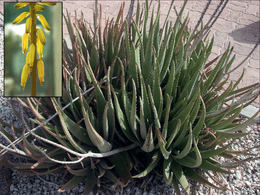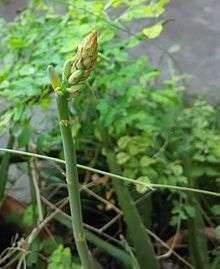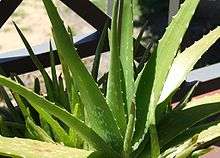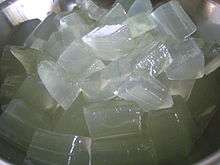Aloe vera
| Aloe vera | |
|---|---|
 | |
| Aloe vera plant with flower detail inset | |
| Scientific classification | |
| Kingdom: | Plantae |
| Clade: | Angiosperms |
| Clade: | Monocots |
| Order: | Asparagales |
| Family: | Asphodelaceae |
| Subfamily: | Asphodeloideae |
| Genus: | Aloe |
| Species: | A. vera |
| Binomial name | |
| Aloe vera (L.) Burm.f. | |
| Synonyms[1][2] | |
| |

Aloe vera (/ˈæloʊiː/ or /ˈæloʊ/) is a succulent plant species of the genus Aloe. It grows wild in tropical climates around the world and is cultivated for agricultural and medicinal uses. Aloe is also used for decorative purposes and grows successfully indoors as a potted plant.[3]
It is found in many consumer products including juice, skin lotion, or ointments for minor burns and sunburns. There is little scientific evidence of the effectiveness or safety of Aloe vera extracts for either cosmetic or medicinal purposes. Studies finding positive evidence are frequently contradicted by other studies.
Description
Aloe vera is a stemless or very short-stemmed succulent plant growing to 60–100 cm (24–39 in) tall, spreading by offsets. The leaves are thick and fleshy, green to grey-green, with some varieties showing white flecks on their upper and lower stem surfaces.[4] The margin of the leaf is serrated and has small white teeth. The flowers are produced in summer on a spike up to 90 cm (35 in) tall, each flower being pendulous, with a yellow tubular corolla 2–3 cm (0.8–1.2 in) long.[4][5] Like other Aloe species, Aloe vera forms arbuscular mycorrhiza, a symbiosis that allows the plant better access to mineral nutrients in soil.[6]
Aloe vera leaves contain phytochemicals under study for possible bioactivity, such as acetylated mannans, polymannans, anthraquinone C-glycosides, anthrones, other anthraquinones, such as emodin, and various lectins.[7][8][9]

Taxonomy and etymology

The species has a number of synonyms: A. barbadensis Mill., Aloe indica Royle, Aloe perfoliata L. var. vera and A. vulgaris Lam.[10][11] Common names include Chinese Aloe, Indian Aloe, True Aloe, Barbados Aloe, Burn Aloe, First Aid Plant.[5][12][13][14][15] The species epithet vera means "true" or "genuine".[12] Some literature identifies the white-spotted form of Aloe vera as Aloe vera var. chinensis;[16][17] however, the species varies widely with regard to leaf spots[18] and it has been suggested that the spotted form of Aloe vera may be conspecific with A. massawana.[19] The species was first described by Carl Linnaeus in 1753 as Aloe perfoliata var. vera,[20] and was described again in 1768 by Nicolaas Laurens Burman as Aloe vera in Flora Indica on 6 April and by Philip Miller as Aloe barbadensis some ten days after Burman in the Gardener's Dictionary.[21]
Techniques based on DNA comparison suggest Aloe vera is relatively closely related to Aloe perryi, a species endemic to Yemen.[22] Similar techniques, using chloroplast DNA sequence comparison and ISSR profiling have also suggested it is closely related to Aloe forbesii, Aloe inermis, Aloe scobinifolia, Aloe sinkatana, and Aloe striata.[23] With the exception of the South African species A. striata, these Aloe species are native to Socotra (Yemen), Somalia, and Sudan.[23] The lack of obvious natural populations of the species has led some authors to suggest Aloe vera may be of hybrid origin.[24]
Distribution
The natural range of A. vera is unclear, as the species has been widely cultivated throughout the world. Naturalised stands of the species occur in the southern half of the Arabian Peninsula, through North Africa (Morocco, Mauritania, Egypt), as well as Sudan and neighbouring countries, along with the Canary, Cape Verde, and Madeira Islands.[10] This distribution is somewhat similar to that of Euphorbia balsamifera, Pistacia atlantica, and a few others, suggesting that a dry sclerophyll forest once covered large areas, but has been dramatically reduced due to desertification in the Sahara, leaving these few patches isolated. Several closely related (or sometimes identical) species can be found on the two extreme sides of the Sahara: dragon trees (Dracaena) and Aeonium being two of the most representative examples.
The species was introduced to China and various parts of southern Europe in the 17th century.[25] The species is widely naturalized elsewhere, occurring in temperate and tropical regions of Australia, South America, Mexico, the Caribbean and southeastern US states.[26] The actual species' distribution has been suggested to be the result of human cultivation (anthropogenic).[19][27]
Cultivation

Aloe vera has been widely grown as an ornamental plant. The species is popular with modern gardeners as a putatively medicinal plant and for its interesting flowers, form, and succulence. This succulence enables the species to survive in areas of low natural rainfall, making it ideal for rockeries and other low water-use gardens.[4] The species is hardy in zones 8–11, although it is intolerant of very heavy frost or snow.[5][28] The species is relatively resistant to most insect pests, though spider mites, mealy bugs, scale insects, and aphid species may cause a decline in plant health.[29][30] This plant has gained the Royal Horticultural Society's Award of Garden Merit.[31]
In pots, the species requires well-drained, sandy potting soil and bright, sunny conditions; however, Aloe plants can burn under too much sun or shrivel when the pot does not drain water. The use of a good-quality commercial propagation mix or packaged "cacti and succulent mix" is recommended, as they allow good drainage.[32] Terra cotta pots are preferable as they are porous.[32] Potted plants should be allowed to completely dry before rewatering. When potted, aloes become crowded with "pups" growing from the sides of the "mother plant", they should be divided and repotted to allow room for further growth and help prevent pest infestations. During winter, Aloe vera may become dormant, during which little moisture is required. In areas that receive frost or snow, the species is best kept indoors or in heated glasshouses.[5]
There is large-scale agricultural production of Aloe vera in Australia,[33] Bangladesh, Cuba,[34] the Dominican Republic, China, Mexico,[35] India,[36] Jamaica,[37] Kenya, Tanzania and South Africa,[38] along with the USA[39] to supply the cosmetics industry.

Uses
Research
There is little scientific evidence of the effectiveness or safety of Aloe vera extracts for either cosmetic or medicinal purposes. A research study finding positive evidence[7] is frequently contradicted by other studies.[40][41][42]
Despite this, the cosmetic and alternative medicine industries regularly make claims regarding the soothing, moisturizing, and healing properties of aloe vera.[7][43]
Two 2009 reviews of clinical studies determined that all were too small and faulty to allow strong conclusions to be drawn, but concluded: "there is some preliminary evidence to suggest that oral administration of aloe vera might be effective in reducing blood glucose in diabetic patients and in lowering blood lipid levels in hyperlipidaemia. The topical application of aloe vera does not seem to prevent radiation-induced skin damage. The evidence regarding wound healing is contradictory. More and better trial data are needed to define the clinical effectiveness of this popular herbal remedy more precisely."[42][44] One of the reviews found that Aloe has not been proven to offer protection for humans from sunburn.[44]
A 2007 review of aloe vera use in burns concluded, "cumulative evidence tends to support that aloe vera might be an effective intervention used in burn wound healing for first- to second-degree burns. Further, well-designed trials with sufficient details of the contents of aloe vera products should be carried out to determine the effectiveness of aloe vera."[45] Topical application of aloe vera may also be effective for genital herpes and psoriasis.[42][46] A 2014 Cochrane review found no strong evidence for the value of topical application of aloe vera to treat or prevent phlebitis caused by intravenous infusion.[47]
Aloe vera gel is used commercially as an ingredient in yogurts, beverages, and some desserts,[48][49][50] although at certain doses, its toxic properties could be severe whether ingested or topically applied.[51] The same is true for aloe latex, which was taken orally for conditions ranging from glaucoma to multiple sclerosis until the FDA required manufacturers to discontinue its use.[52]
Dietary supplement
Aloin, a compound found in the exudate of some Aloe species, was the common ingredient in over-the-counter (OTC) laxative products in the United States until 2002 when the Food and Drug Administration banned it because the companies manufacturing it failed to provide the necessary safety data.[53][54] Aloe vera has potential toxicity, with side effects occurring at some dose levels both when ingested or applied topically.[51] Although toxicity may be less when aloin is removed by processing, Aloe vera that contains aloin in excess amounts may induce side effects.[7][42][55]
Aloe vera juice is marketed to support the health of the digestive system, but there is neither scientific evidence nor regulatory approval to support this claim.[56] The extracts and quantities typically used for such purposes appear to be dose-dependent for toxic effects.[51]
Traditional medicine
Aloe vera is used in traditional medicine as a skin treatment. In Ayurvedic medicine it is called kathalai, as are extracts from agave.[57]:196 for aloe:117 for agave Early records of Aloe vera use appear in the Ebers Papyrus from the 16th century BC,[15]:18 and in Dioscorides' De Materia Medica and Pliny the Elder's Natural History – both written in the mid-first century AD.[15]:20 It is also written of in the Juliana Anicia Codex of 512 AD.[48]:9 The plant is used widely in the traditional herbal medicine of many countries.
Commodities
Aloe vera is used on facial tissues where it is promoted as a moisturiser and anti-irritant to reduce chafing of the nose. Cosmetic companies commonly add sap or other derivatives from Aloe vera to products such as makeup, tissues, moisturizers, soaps, sunscreens, incense, shaving cream, or shampoos.[48] A review of academic literature notes that its inclusion in many hygiene products is due to its "moisturizing emollient effect".[9]
Other potential uses for extracts of Aloe vera include the dilution of semen for the artificial fertilization of sheep,[58] as a fresh food preservative,[59] or for water conservation in small farms.[60] It has also been suggested that biofuels could be obtained from Aloe vera seeds.[61]
Toxicity
Under the guidelines of California Proposition 65, orally ingested non-decolorized aloe vera leaf extract has been listed by the OEHHA, along with goldenseal, among "chemicals known to the state to cause cancer or reproductive toxicity".[62]
Use of topical aloe vera is not associated with significant side effects.[53] Oral ingestion of aloe vera, however, may cause abdominal cramps and diarrhea which in turn can decrease the absorption of drugs.[53] IARC studies have found ingested non-decolorized liquid aloe vera[63] to be carcinogenic in animals, and state that it is a possible carcinogen in humans as well.[64]
See also
- Herbal medicine
- Medicinal plants
- Museo de Aloe de Lanzarote, Aloe vera museum in the Canary Islands, Spain
- Succulent plants
References
- ↑ Aloe vera (L.) Burm. f. Tropicos.org
- ↑ Aloe vera (L.) Burm.f. is an accepted name . theplantlist.org
- ↑ Perkins, Cyndi. "Is Aloe a Tropical Plant?". SFgate.com. Retrieved 13 Feb 2016.
- 1 2 3 Yates A. (2002) Yates Garden Guide. Harper Collins Australia
- 1 2 3 4 Random House Australia Botanica's Pocket Gardening Encyclopedia for Australian Gardeners Random House Publishers, Australia
- ↑ Gong M, Wang F, Chen Y (2002). "[Study on application of arbuscular-mycorrhizas in growing seedings of Aloe vera]". Zhong Yao Cai (in Chinese). 25 (1): 1–3. PMID 12583231.
- 1 2 3 4 Boudreau MD, Beland FA (2006). "An Evaluation of the Biological and Toxicological Properties of Aloe Barbadensis (Miller), Aloe Vera". J Environ Sci Health C Environ Carcinog Ecotoxicol Rev. 24 (1): 103–54. doi:10.1080/10590500600614303. PMID 16690538.
extract in various solvents has variable but significant antibacterial activity against the five clinical isolates used in this study.
- ↑ King GK, Yates KM, Greenlee PG, Pierce KR, Ford CR, McAnalley BH, Tizard IR (1995). "The effect of Acemannan Immunostimulant in combination with surgery and radiation therapy on spontaneous canine and feline fibrosarcomas". J Am Anim Hosp Assoc. 31 (5): 439–47. doi:10.5326/15473317-31-5-439. PMID 8542364.
- 1 2 Eshun K, He Q (2004). "Aloe vera: a valuable ingredient for the food, pharmaceutical and cosmetic industries--a review". Crit Rev Food Sci Nutr. 44 (2): 91–6. doi:10.1080/10408690490424694. PMID 15116756.
- 1 2 "Aloe vera, African flowering plants database". Conservatoire et Jardin botaniques de la Ville de Genève. Retrieved 2008-06-20.
- ↑ "Taxon: Aloe vera (L.) Burm. f.". Germplasm Resources Information Network, United States Department of Agriculture. Retrieved 2008-07-16.
- 1 2 Ombrello, T. "Aloe vera". Archived from the original on 5 July 2008. Retrieved 2008-06-21.
- ↑ Liao Z, Chen M, Tan F, Sun X, Tang K (2004). "Microprogagation of endangered Chinese aloe". Plant Cell, Tissue and Organ Culture. 76 (1): 83–86. doi:10.1023/a:1025868515705.
- ↑ Jamir TT, Sharma HK, Dolui AK (1999). "Folklore medicinal plants of Nagaland, India". Fitoterapia. 70 (1): 395–401. doi:10.1016/S0367-326X(99)00063-5.
- 1 2 3 Barcroft, A. and Myskja, A. (2003) Aloe Vera: Nature's Silent Healer. BAAM, USA. ISBN 0-9545071-0-X
- ↑ Wang H, Li F, Wang T, Li J, Li J, Yang X, Li J (2004). "[Determination of aloin content in callus of Aloe vera var. chinensis]". Zhong Yao Cai (in Chinese). 27 (9): 627–8. PMID 15704580.
- ↑ Gao W, Xiao P (1997). "[Peroxidase and soluble protein in the leaves of Aloe vera L. var. chinensis (Haw.)Berger]". Zhongguo Zhong Yao Za Zhi (in Chinese). 22 (11): 653–4, 702. PMID 11243179.
- ↑ Akinyele BO, Odiyi AC (2007). "Comparative study of the vegetative morphology and the existing taxonomic status of Aloe vera L.". Journal of Plant Sciences. 2 (5): 558–563. doi:10.3923/jps.2007.558.563.
- 1 2 Lyons G. "The Definitive Aloe vera, vera?". Huntington Botanic Gardens. Archived from the original on 25 July 2008. Retrieved 2008-07-11.
- ↑ Linnaeus, C. (1753). Species plantarum, exhibentes plantas rite cognitas, ad genera relatas, cum differentiis specificis, nominibus trivialibus, synonymis selectis, locis natalibus, secundum systema sexuale digestas. Vol. 2 pp. [i], 561–1200, [1–30, index], [i, err.]. Holmiae [Stockholm]: Impensis Laurentii Salvii.
- ↑ Newton LE (1979). "In defense of the name Aloe vera". The Cactus and Succulent Journal of Great Britain. 41: 29–30.
- ↑ Darokar MP, Rai R, Gupta AK, Shasany AK, Rajkumar S, Sunderasan V, Khanuja SP (2003). "Molecular assessment of germplasm diversity in Aloe spp. using RAPD and AFLP analysis". J Med. Arom. Plant Sci. 25 (2): 354–361.
- 1 2 Treutlein J, Smith GF, van Wyk BE, Wink W (2003). "Phylogenetic relationships in Asphodelaceae (Alooideae) inferred from chloroplast DNA sequences (rbcl, matK) and from genomic finger-printing (ISSR)". Taxon. 52 (2): 193. doi:10.2307/3647389. JSTOR 3647389.
- ↑ Jones WD, Sacamano C. (2000) Landscape Plants for Dry Regions: More Than 600 Species from Around the World. California Bill's Automotive Publishers. USA.
- ↑ Farooqi, A. A. and Sreeramu, B. S. (2001) Cultivation of Medicinal and Aromatic Crops. Orient Longman, India. ISBN 8173712514. p. 25.
- ↑ "Aloe vera". Royal Botanic Gardens, Kew. 2016. Retrieved 10 August 2016.
- ↑ "Aloe vera (Linnaeus) Burman f., Fl. Indica. 83. 1768." in Flora of North America Vol. 26, p. 411
- ↑ "BBC Gardening, Aloe vera". British Broadcasting Corporation. Retrieved 2008-07-11.
- ↑ "Pest Alert: Aloe vera aphid Aloephagus myersi Essi.". Florida Department of Agriculture and Consumer Services. Archived from the original on 12 June 2008. Retrieved 2008-07-11.
- ↑ "Kemper Center for Home Gardening: Aloe vera". Missouri Botanic Gardens, USA. Retrieved 2008-07-11.
- ↑ "RHS Plant Selector Aloe vera AGM / RHS Gardening". Apps.rhs.org.uk. Retrieved 2012-11-09.
- 1 2 Coleby-Williams, J. "Fact Sheet: Aloes". Gardening Australia, Australian Broadcasting Corporation. Archived from the original on 6 July 2008. Retrieved 2008-07-08.
- ↑ "Aloe vera producer signs $3m China deal". Australian Broadcasting Corporation. Retrieved 2008-07-08.
- ↑ "More Medicinal Plants Grow in Ciego de Ávila". invasor.cu. Retrieved 2008-06-25.
- ↑ "Korea interested in Dominican 'aloe vera'". DominicanToday.com—The Dominican Republic News Source in English. Retrieved 2008-07-19.
- ↑ Varma, Vaibhav (11 December 2005). "India experiments with farming medicinal plants". channelnewsasia.com.
- ↑ "Harnessing the potential of our aloe". Jamaica Gleaner, jamaica-gleaner.com. Retrieved 2008-07-19.
- ↑ "Kenya: Imported Gel Hurts Aloe Vera Market". allafrica.com. Retrieved 2008-06-25.
- ↑ "US Farms, Inc. – A Different Kind of Natural Resource Company". resourceinvestor.com. Retrieved 2008-07-19.
- ↑ Ernst E (2000). "Adverse effects of herbal drugs in dermatology". Br. J. Dermatol. 143 (5): 923–9. doi:10.1046/j.1365-2133.2000.03822.x. PMID 11069498.
Oral and topical aloe vera is promoted for a variety of conditions but the evidence to support its use is not compelling.
- ↑ Marshall JM (1990). "Aloe vera gel: what is the evidence?". Pharm J. 244: 360–362.
- 1 2 3 4 Vogler BK, Ernst E (1999). "Aloe vera: a systematic review of its clinical effectiveness" (PDF). Br J Gen Pract. 49 (447): 823–8. PMC 1313538
 . PMID 10885091.
. PMID 10885091. - ↑ Kunkel. G. (1984) Plants for Human Consumption. Koeltz Scientific Books. ISBN 3-87429-216-9
- 1 2 Feily A, Namazi MR (2009). "Aloe vera in dermatology: a brief review". G Ital Dermatol Venereol. 144: 84–91.
- ↑ Maenthaisong R, Chaiyakunapruk N, Niruntraporn S, Kongkaew C (2007). "The efficacy of aloe vera used for burn wound healing: a systematic review" (PDF). Burns. 33 (6): 713–8. doi:10.1016/j.burns.2006.10.384. PMID 17499928.
- ↑ Deng S, May BH, Zhang AL, Lu C, Xue CC (2013). "Plant extracts for the topical management of psoriasis: a systematic review and meta-analysis". Br. J. Dermatol. 169 (4): 769–82. doi:10.1111/bjd.12557. PMID 23909714.
- ↑ Zheng GH, Yang L, Chen HY, Chu JF, Mei L (2014). "Aloe vera for prevention and treatment of infusion phlebitis". Cochrane Database Syst Rev. John Wiley & Sons. 6 (6): CD009162. doi:10.1002/14651858.CD009162.pub2. PMID 24895299. (subscription required (help)).
- 1 2 3 Reynolds, Tom (Ed.) (2004) Aloes: The genus Aloe (Medicinal and Aromatic Plants - Industrial Profiles. CRC Press. ISBN 978-0415306720
- ↑ Armstrong, Liza. "Clean and green". Australian Broadcasting Corporation. Archived from the original on 24 May 2008. Retrieved 2008-06-20.
- ↑ "Yagua unveils cosmeceutical beverage". Decision News Media. Retrieved 2008-06-20.
- 1 2 3 Cosmetic Ingredient Review Expert Panel (2007). "Final Report on the Safety Assessment of Aloe Andongensis Extract, Aloe Andongensis Leaf Juice, Aloe Arborescens Leaf Extract, Aloe Arborescens Leaf Juice, Aloe Arborescens Leaf Protoplasts, Aloe Barbadensis Flower Extract, Aloe Barbadensis Leaf, Aloe Barbadensis Leaf Extract, Aloe Barbadensis Leaf Juice, Aloe Barbadensis Leaf Polysaccharides, Aloe Barbadensis Leaf Water, Aloe Ferox Leaf Extract, Aloe Ferox Leaf Juice, and Aloe Ferox Leaf Juice Extract" (PDF). Int. J. Toxicol. 26 (Suppl 2): 1–50. doi:10.1080/10915810701351186. PMID 17613130.
- ↑ "Aloe". WebMD.
- 1 2 3 "Aloe Vera : Science and Safety | NCCIH". Nccih.nih.gov. Retrieved 2014-01-31.
- ↑ Food Drug Administration, HHS (2002). "Status of certain additional over-the-counter drug category II and III active ingredients. Final rule". Fed Regist. 67 (90): 31125–7. PMID 12001972.
- ↑ Bottenberg MM, Wall GC, Harvey RL, Habib S (2007). "Oral aloe vera-induced hepatitis". Ann Pharmacother. 41 (10): 1740–3. doi:10.1345/aph.1K132. PMID 17726067.
- ↑ "Aloe (Aloe vera)". MayoClinic.com. 2012-09-01. Retrieved 2012-11-09.
- ↑ Quattrocchi, Umberto (2012) CRC World Dictionary of Medicinal and Poisonous Plants: Common Names, Scientific Names, Eponyms, Synonyms, and Etymology (5 Volume Set) CRC Press. ISBN 978-1420080445
- ↑ Rodriguez F, Baldassarre H, Simonetti J, Aste F, Ruttle JL (1988). "Cervical versus intrauterine insemination of ewes using fresh or frozen semen diluted with aloe vera gel". Theriogenology. 30 (5): 843–54. doi:10.1016/S0093-691X(88)80046-3. PMID 16726526.
- ↑ Serrano M, Valverde JM, Guillén F, Castillo S, Martínez-Romero D, Valero D (2006). "Use of Aloe vera gel coating preserves the functional properties of table grapes". J. Agric. Food Chem. 54 (11): 3882–6. doi:10.1021/jf060168p. PMID 16719510.
- ↑ "Water conservation". Chennai, India: The Hindu. 2008-07-10. Archived from the original on 2 August 2008. Retrieved 2008-07-14.
- ↑ Shukla, S. "Aloe Vera has biodiesel potential, reveals MSU study". The Indian Express. Retrieved 2008-06-21.
- ↑ Proposition 65. Chemicals Listed Effective December 4, 2015 as Known to the State of California to Cause Cancer: Aloe Vera, Non-Decolorized Whole Leaf Extract and Goldenseal Root Powder. U.S. Office of Environmental Health Hazard Assessment (December 4, 2015)
- ↑ "Aloe Vera | NCCIH". NCCIH. Retrieved 2016-03-01.
- ↑ Preamble in IARC Monographs on the Evaluation of Carcinogenic Risks to Humans. International Agency for Research on Cancer, Lyon, France (2006)
External links
| Wikimedia Commons has media related to Aloe vera. |